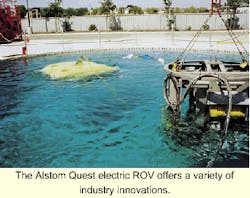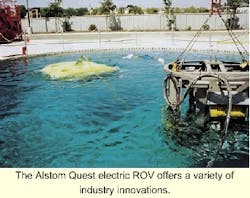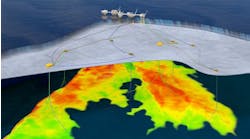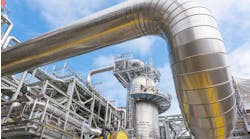An anology made by Tyler Schilling of Alstom Schilling Robotics in 1998 captures the goals and effort behind the ongoing development of all-electric remotely operated vehicles (ROV). During a meeting at the onset of the Quest all-electric ROV, Schilling pointed to a cell phone and the ease of removing and replacing the battery. He said it should be as easy to connect and disconnect any electrical connector on an ROV, and that if the job is done right, the ROV will work so well that no one will think to ask why.
Schilling had a point. The ROV industry is largely dominated by "horsepower," but it should be focus more on reliability. ROVs are involved
in critical-path support operations on very ex pensive projects. If the ROV is down, it can mean the entire operation is off line.
Many companies in the ROV industry have impressive reliability records, but the cost in manpower, supplies, training, and equipment is high. Schilling said the reason maintenance is such a large percentage of the ROV cost is that the vehicles have become too complicated. This is the result of evolutionary technology - a technology developed incrementally over time. While there are often innovations and improvements in ROV technology, the basic design has remained the same for decades.
Comoditizaton of ROVs
No one in the industry is particularly interested in innovations for ROVs. What they are interested in is price and cost of operations. The ROV market is close to saturation on the heels of the current slowdown in exploration. Operators are looking for low cost and they are not particular where it comes from. Because of this, many companies have started building their own ROVs, convinced they can assemble the various component parts as well as an ROV manufacturing company and save some money in the process.
While this makes for stiff competition on price, there are innovations coming to the market. Some companies such as Oceaneering, and Sonsub are designing new work class units and adding money-saving innovations, but even these designers will admit that with a large stake in the ROV fleet currently on the market, it is not practical to launch an all-new design.
Oceaneering for example is building an all-electric work class ROV, but the design is being phased in and is supported by its large fleet of similar electro-hydraulic vehicles. From a reliability standpoint, the company needs to have a replacement ROV available at a moment's notice. At the same time, for most current applications, the electro-hydraulic vehicle will function just fine. The reason Oceaneering is venturing forward with an all-electric vehicle is to be prepared for a time when applications will go beyond what the hydraulic units can accomplish.
Well armed
Schilling robotics is known as a provider of manipulator arms, and technicians are constantly testing aluminum and titanium arms. The company began designing arms for a variety of industries, including nuclear power and defense, but has moved almost exclusively into commercial offshore (oil, gas, and telecom). He said other industries did not offer the return on research and development he was seeking. In many cases, the company would make a major investment to design an arm that would be a "one off" or one-of-a-kind design. While such work was lucrative in the context of the single project, Schilling said there was no residual value to the lessons learned.
The company made a conscious effort to direct its work toward an industry where standardization would allow Schilling to make the most of each design in terms of lowering the recurring costs and spreading the R&D expense over as many units as possible. Following this direction, Schilling said his company embraced the concept of mass production for all components. The cost of such an approach is much higher up front as specialized dies and tools must be fabricated initially, but in the long run, there is a savings that offsets this expense. The position achieved by Schilling in the manipulator arm market allowed the firm sufficient leverage to expand into the ROV business.
Backed by funding from Alstom, Schilling looked at other components of the ROV that would benefit from this heavy research and development and mass production. "Our focus is at the subsystem level in the context of what a turnkey system is," Schilling said. Using the basic components Schilling produces, a customer could assemble their own ROV, or have Alstom build the turnkey unit, such as the Quest all-electric ROV.
Schilling said this approach addresses two primary customer groups, those interested in ROVs and those interested in purchasing the pre-integrated components for their own ROVs. Schilling said many companies have expertise in operating ROVs rather than constructing them. These companies can benefit from Alstom's Quest ROV design.
Those companies who manufacture their own ROVs can use the pre-integrated components in their own design without having a higher cost per unit to pass on to customers. To return to the cell phone analogy, if each user constructed his own unit, all would be very much more expensive. Schilling said the company's goal is not to drive competition from the market, but to have its components accepted and integrated into this market.
Mass production
The company spent two years and several million dollars developing a series of integrated components and the facilities to mass-produce them. Using advanced injection molding techniques and specially designed tooling systems, Schilling said the company can produce a more uniform line of components than is possible when cutting each piece from an individual block of material.
The key to making these high up-front costs pay off is in the design. The design must be refined and exact, so that it will not need to be modified later and create enough demand to justify the startup costs.
If Alstom can produce hundreds of these components, rather than ten or so, it can realize a savings and pass that on to consumers. Because many of these components are made from specialized plastics, they weigh less than metal parts, are less susceptible to corrosion, and can easily be mass produced. This lowers the spare parts expenses as well as the manufacturing cost of each unit.
ROV manufacturers regularly purchase key components, such as thrusters, from outside vendors, Schilling said, in addition to the manipulator arms. Typically, the integration of all these divergent systems is a major challenge for the ROV, and Schilling said the components his company is designing would simplify this difficulty.
Wes Garriets, Vice President with Alstom, said the microchip as an example of an enabling technology that made new design possible. The standardized cabling and connectors that make the Alstom components easier to integrate depend on rugged technology.
Cost of ownership
The majority of downtime on ROVs reportedly can be traced to two problems - faulty electrical interconnections and hydraulic leaks. This is more than a question of how the components are initially designed. Schilling said the component design is critical, but it also is important to consider how the customer interacts with the design.
In some cases, troubleshooting a problem can cause a simple failure to escalate into a complex problem. Beyond this, there is an obvious advantage to reducing the number of electrical cables used in the ROV. Alstom designed a networking connection installed in the SeaNet hub (smaller version of an electronics bottle) that reduces the amount of cabling by 90%. This means fewer connections, fewer wires to trace and fewer things that can go wrong.
In addition, the connections of the cable itself have been redesigned for greater simplicity. There is one size and style of connection throughout the system. It is a simple quick-connect design that uses LED lights to verify when a good connection is made. Schilling said the goal was to make a connection simple and intuitive. This design was one of the most difficult the team faced, but Schilling is convinced it will pay off for the owner of the ROV by eliminating downtime due to human error.
In addition to reducing the amount of cabling and simplifying the connectors, Alstom reduced the number of unique devices on the ROV. Typically, it takes in about 250 devices to make up an electro-hydraulic work class ROV. Quest has reduced this to 50. That means fewer components technicians must familiarize themselves with and a smaller inventory of spare parts.
By designing simple versatile devices, the firm is able to use the same components for several applications on the vehicle and on the corresponding tether management system (TMS). Schilling cites the rotary actuator. This component is used for the pan and tilt of cameras, the pop-up devices, the TMS latch, and a variety of other applications requiring something to move or turn. Schilling said it is not so much the number of overall devices that is a problem, but the number of distinct devices. "Variety is what kills you," he said.
Electric ring thruster
One of the core components to the new design is the electric ring thruster. This 7.5 kW unit replaces the hydraulic thruster used on current work class ROV designs. The electric ring thruster is based on research carried out by the Harbor Branch Oceanographic Institute. The thruster weighs only 55 lbs. in water and it uses a brushless, frameless DC motor technology. It has a maximum rated thrust of 450 lbf. - The smaller profile of the Quest gives it an increased operating envelope.
The main components of the thruster are a stator, rotor assembly, two nozzles, and a motor controller. The five thruster blades are attached to the inside diameter of the rotor. The hub-less design allows the motor to provide equal thrust in both directions. The typical hydraulic thruster loses 20-40% of its power in the reverse direction.
The thruster is built to be easily serviced. Each blade is held in place by four screws and the individual blades can be replaced without disassembling any other part of the unit. Each of the nozzles can be replaced by unfastening a circumferential band. Major service operations require only 30 minutes on deck.
Because the thruster uses a direct electric drive it eliminates many of the power conversion inefficiencies that are inherent in hydraulic propulsion systems. In conventional hydraulic propulsion systems, electric power is applied to a hydraulic power unit which runs a hydraulic motor which rotates the thruster blades. At each stage of this power conversion process, there are losses such that the efficiency from the electric power input at the hydraulic power unit is reduced by 35% at the time it reaches the thruster shaft.
The direct drive electric thruster receives input from a high-voltage converter reducing this loss to 15%. Alstom says the all-electric system is more reliable than the hydraulic system simply because a hydraulic system is vulnerable to leaks in shaft seals, hydraulic hoses, and compensation systems. Seawater intrusion disables not only the hydraulic thrusters but often the entire hydraulic system.
Most of the components for the electric thruster are made from engineering thermoplastics. The magnets in the rotor and the windings in the stator are encapsulated in plastic to eliminate the possibility of water intrusion and remove voids that would require pressure compensation. The thruster blades are made from a glass fiber reinforced plastic. The rotor assembly is the only moving part on the thruster.
The electric ring thruster is brushless so the rotor/stator gap is open to filtered seawater. This design permits the use of seawater to form a hydrodynamic bearing that eliminates the need for an oil-filled, sealed bearing system. As the rotor turns, a film of water develops between the stationary and rotating surfaces, separating them. The faster the rotation, the greater the force keeping the two surfaces apart. This contact-free bearing system eliminates wear, so that the only service the thruster should require is the occasional replacement of the filter that protects the rotor/bearing interface from particulate matter in the seawater.
Each motor has an integrated controller with a digital interface. An enclosure for control electronics is attached directly to the stator body and is oil filled for pressure compensation. This enclosure contains only two printed circuit boards. Locating the controller directly on the thruster assembly eliminates the failures from snagged cables and loose connections. Digital control allows the motor to shut off if it senses the thruster is getting into trouble and gives the operator enhanced feedback.
The hydraulic power unit (HPU) on the Quest electric unit uses the same motor as the thrusters to deliver hydraulic power to tools. The motor is servo-controlled so that the flow rate and pressure can be varied, which translates to specific power control. The units can be stacked so that as many as three can work together, increasing the power level.
Tether management system
Component commonality is one of the Quest unit's chief themes, and the tether management system uses two of the thruster motors equipped with a toothed belt pulley installed on the shaft and connected to the devices on the TMS. One of the motors operates the spool, while the other drives a traction drive wheel to regulate the tension on the tether. These motors are identical to and interchangeable with the thruster motors.
The tether designed for the Quest ROV uses optical fibers, which allow more data to be transmitted back and forth, but also requires delicate handling. The thruster motor allows for variable speeds when winding or unwinding the tether on the spool. A low speed could be used in making adjustments in the amount of tether played out, while a higher speed could be used for situations such as docking, where the tether must be reeled in very fast.
In addition to variable speeds this design offers variable tension. The variable tension is helpful in situations where the TMS is moving up and down such as in heavy seas. The drum on which the tether is spooled moves back and forth to ensure the cable winds evenly. Other designs snake the tether through an S-bend to wind it on the spool using a guide. This can produce counter-bending, which fatigues the tether, Schilling pointed out. The goal of this design is to extend the tether's life. Because of the increased efficiency of the electric thrusters, the umbilical cable, which links the support vessel and the TMS, shrinks dramatically in diameter to 27 mm. This umbilical size reduction alone lowers total system weight by 20,000 lb and reduces drag.
Operating costs
When a company purchases an ROV, there are two major cost components. The first is the acquisition cost - the amount paid for the vehicle. The second cost component is the operating cost - everything involved in running the vehicle and everything that causes it to sit idle. According to Schilling, every aspect of the Quest ROV design has focused on reducing one or both of these cost components.
Schilling said there are a number of factors contributing to the operating cost. First is the vehicle's productivity. This refers to how quickly, reliably, and consistently the ROV can do a job. There is also a consideration for how many people it takes to operate the ROV and what level of training is required.
Mobilization costs also fall into this category. In some cases, this will be a greater factor than in others. If the ROV is purchased or contracted for call out work that lasts just a few days mobilization costs can add up quickly. On the other hand, if the unit is contracted as equipment on a large drilling vessel, then mobilization is not a big issue.
The operating envelope is a critical cost area. The weather limits, tool capacity, and accessibility of the vehicle are important as well as the depth capability. To work, a vehicle has to be able to hold its position and use the specified tools in the given work space under varying weather conditions.
Schilling compares the new design to an automobile. An automobile car is a complicated machine, but easy enough for anyone with basic training to operate. A typical driver in a reasonably well maintained car needn't worry about destination when the machine is started. Schilling's point is that an ROV should be similar to operate.
Currently, ROV operations rely on a core group of highly trained and skilled pilots and maintenance technicians working round the clock. There is downtime built into ROV operations to allow for maintenance. Schilling said he would like to see an ROV virtually anyone could operate without a concern for failures. "We're trying to take a huge step to simplify the ownership and operation of these machines," he said.
Canyon Offshore has taken the lead in supporting the Quest, contracting to buy the first seven produced. Graham Openshaw, Vice President for Commercialization with Canyon, said his company believes the Quest vehicles have a number of significant advantages, including:
- A smaller cross-sectional area per unit of thrust, providing an improved operating envelope over a typical 100 hp work class ROV.
- Smaller system size and weight, reducing deck requirements and mobilization costs.
- Reduced system complexity resulting in improved reliability and lower operating costs.
- An advanced user interface resulting in improved operating efficiency and a better overall service.
Openshaw said Canyon is confident once Canyon gains experience with the system he believe the Quest may offer advantages across all sectors of the market.




